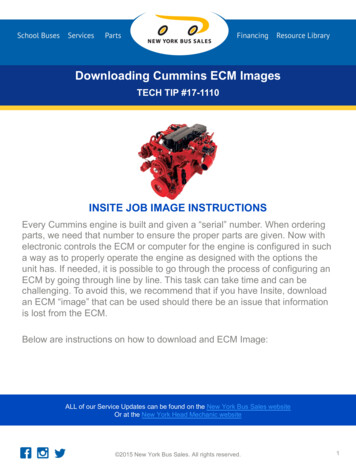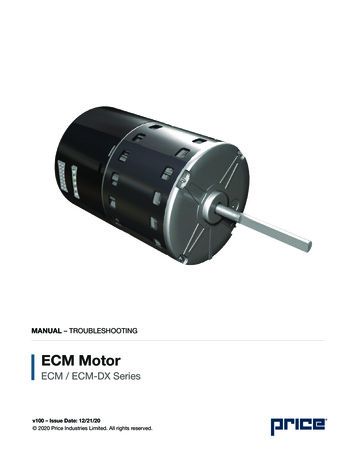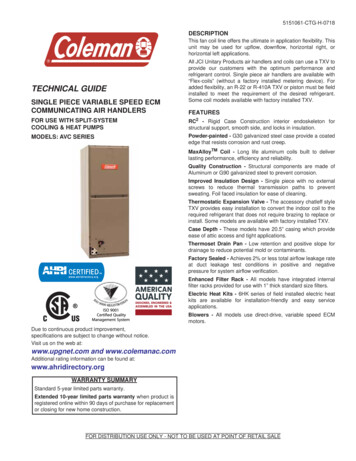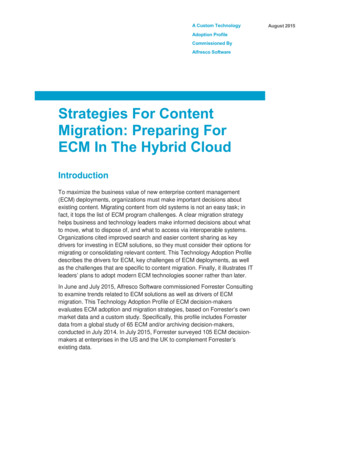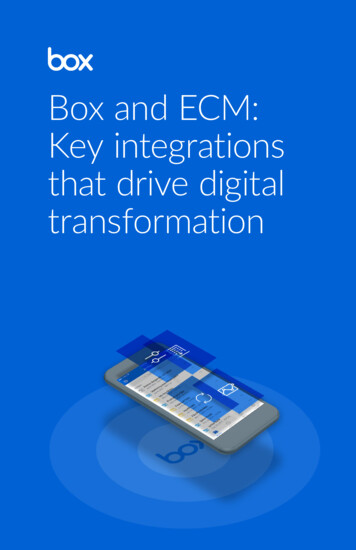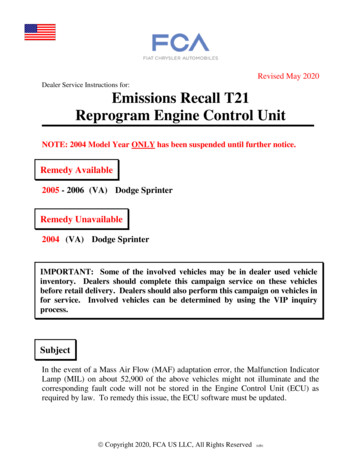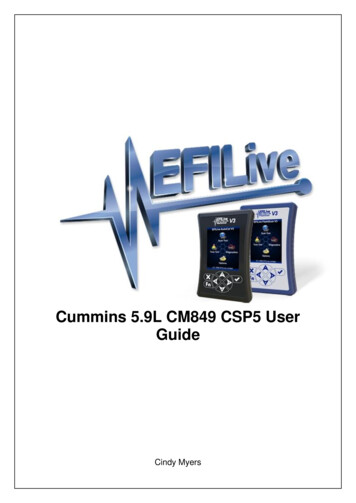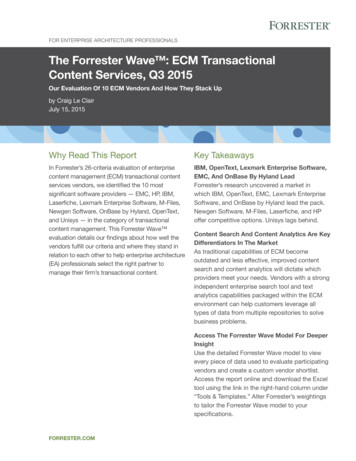
Transcription
Conduent HealthHealthcare Provider SolutionsDesigning a Modern, Holistic ECMStrategy for HealthcareHow ECM consulting helps healthcare providers thrivein an atmosphere of change.
Conduent HealthHealthcare Provider SolutionsExecutive SummaryToday’s healthcare industry is undergoing continual transformation to meet everevolving standards. Collectively, accountable care, population health, ICD-10, and therising incidence of audits and takebacks require hospitals and health systems to evaluatetheir business processes and improve accountability. To meet these increasing demands,many healthcare providers are embracing innovative technology solutions.Among the most promising technologies is enterprise content management (ECM),which can transform the way healthcare providers capture, analyze and report onmeaningful patient care data while improving patient outcomes. According to therespected research organization AIIM, an effective ECM implementation encompassesthe strategies, methods and tools used to capture, manage, store, preserve and delivercontent and documents related to organizational processes.However, many ECM projects fall short of expectations or fail completely due tomisguided requirements, improper process assessment, and a lack of a strategic plan.To reap the benefits of ECM, healthcare organizations must focus not just on thetechnology, but also on the true operational problems and workflow inefficiencies thatECM can resolve. Successful implementations require coupling the technology withhealthcare operations subject matter expertise.As we’ll show in this white paper, an effective ECM implementation involves evaluatingbusiness processes and determining how to capture vast quantities of unstructured datato improve mobility, collaboration, reimbursement, regulatory compliance and ultimatelypatient care. A holistic, enterprise-grade ECM solution can help the organization thrive inan atmosphere of change—today and for years to come.The Challenge: Unstructured Data Limits Efficiency and MobilityHealthcare is destined for a digital future. However, paper continues to maintain astronghold over administrative and clinical operations. Just 35% of organizations have amandate to drive paper out of the business, with only 19% having endorsement at theboard level. And as many as 56% have an environmental impact policy that requires areduced use of paper, but only 24% actively promote it.1The implications of this extend far beyond any environmental effects. Electronic medicalrecords have changed the way clinical data is captured. Structured data (patient names,diagnosis codes, etc.) is standardized and easily accessible from anywhere within theorganization and beyond.However, a significant amount of unstructured content is developed during the patientcare lifecycle. It comprises all of the information that resides outside of an accessible,standardized computer platform. It includes everything from handwritten notes on paperforms and signed patient consent forms to referrals, faxes, invoices, purchase orders,audio files, email messages, and more.2
Conduent HealthHealthcare Provider SolutionsThere is a general consensus amonganalysts from Gartner and Merrill Lynch thatunstructured data accounts for 80% of the datathat exists in a healthcare organization.There is a general consensus among analysts from Gartner and Merrill Lynch thatunstructured data accounts for 80% of the data that exists in a healthcare organization.Moreover, the Health Story Project estimates that 1.2 billion clinical documents areproduced in the U.S. each year. Nearly 60% of these documents contain valuable patientcare data that’s inaccessible to clinicians.2Most unstructured content exists within departmental silos. These silos prevent keystakeholders from gaining a holistic view of the high-level priorities and performanceof the organization. Electronic health records (EHRs) offer many benefits, but EHRs areoften data silos in their own right.Studies show that 79% of physicians believethe use of mobile devices can help cliniciansimprove the coordination of care.Moreover, as computers replace paper-based documentation in healthcare systems,technology often becomes a barrier between clinicians and patients. Yet whenclinicians and patients can access content from any device at any location, this barrierdiminishes. Studies show that 79% of physicians believe the use of mobile devices canhelp clinicians improve the coordination of care.3 Whether a physician needs to reviewlabs or collaborate with another provider from outside the four walls of the hospital,unstructured content severely restricts the flexibility and agility that mobile devices offer.In addition to patient care and service, unstructured content poses a threat to efficiencyand productivity in multiple back-office departments including: Compliance Accounting Legal Facilities management Medical records Finance Hospital administration Record security Disaster recoveryThe bottom line is that much of the clinical and operational data that is needed toprovide quality patient care, ensure regulatory compliance, and accelerate paymentcycles is difficult to access and standardize across the organization. And without aholistic, integrated view of clinical and operational content, patient care and service canbecome inefficient and operational costs can rise.Solution: Designing a Holistic ECM ApproachClearly, the impact of such vast quantities of unstructured content is significant. Thisis where enterprise content management comes into play. With ECM, healthcareorganizations can manage all content centrally and securely while offering individualusers and departments the flexibility and agility they need to accomplish importantclinical and operational objectives. ECM perfectly complements EHRs and other clinicaland back-office applications.3
Conduent HealthHealthcare Provider SolutionsCreating a Holistic ECM SolutionWhile the advantages of ECM are many, to truly capitalize on them and realize asignificant return on investment, healthcare organizations must design an ECM solutionwith business process improvement in mind. When an organization focuses exclusivelyon the technology without regard to the business processes it must accommodate, ECMwill fall short of expectations or fail completely. To reap the benefits of ECM, healthcareorganizations must design a solution through a proper assessment of current stateprocesses and the development of an optimized future state.When an ECM solution is designed with aholistic approach, benefits stretch acrossthe enterprise.For example, an ECM solution focused on business process improvement would identifyhow paperwork demands are escalating for clinicians. According to a survey by thePhysician’s Foundation, physicians spend more than 22% of their time on non-clinicalpaperwork. The effective ECM strategy would consider how paperwork is tied tophysician and patient satisfaction and include process improvements to addressthe issue.When an ECM solution is designed with a holistic approach, benefits stretch acrossthe enterprise. Departmental silos are eliminated, ensuring that all structured andunstructured content is accessible from everywhere in the organization.A holistic approach also ensures that cost svavings and patient outcome improvementsare not limited to specific clinical and operational areas. With the right strategy,the automation that ECM provides will extend productivity and efficiency benefitsthroughout the enterprise.Success StoryA large healthcare facilities operator needed a way to connect data from 700locations using more than 20 EMR vendors. Conduent ECM Consulting used avendor neutral approach to integrate data and provide access from any location.With ECM, the organization was able to streamline workflows associated withsharing information and broaden access to critical data for decision-making.Performing a Business Process AssessmentIn addition to ensuring a holistic approach and enabling mobile access, the right ECMstrategy will include a thorough assessment of the clinical and business processes thatthe ECM technology must accommodate. A proper assessment will ensure that theECM platform is built with a true understanding of the organization’s current state andwithout a shortsighted future state design. All business process improvements must bedesigned around the organization’s true needs, not around the vendor’s platform.All business process improvements must bedesigned around the organization’s true needs,not around the vendor’s platform.The first thing to consider when conducting an assessment is that all requirements andexpectations need to be gathered and documented with the overall enterprise strategyin mind. Those requirements can then be mapped to specific business processes andECM tactics that achieve those strategic objectives.4
Conduent HealthHealthcare Provider SolutionsPhysicians Report performing morehealthcare activities on a mobile deviceduring the last 4 yearsBeyond this, the proper assessment methodology will focus on the people and processeswithin the organization. This involves: Identifying where an ECM solution would have the greatest potential Determining how unstructured content enters and exits the organization Documenting the content and business requirements the organization expectsto address Identifying problem areas like gaps, risks and bottlenecks where work slows or stops Interacting with employees and observing their daily operations. The actual activitiesperformed by an organization or department can be different from what theiremployees may describe, so observation is crucial Reviewing content lifecycles to evaluate how content is created and determineorganizational touch points, workflow implications, and business impacts(e.g., revenue, cash flow, patient LOS, risk, compliance, etc.)Source: 2014 HR Clinician Workforce Survey & 2010 Physicians Survey Planning for change management and a long-term vision across the organizationOnce these activities are performed, a roadmap can be created, identifying an ECMsolution that addresses the business process improvement opportunities unique tothe organization.The modern ECM platform must accommodategrowing needs for mobility and collaborationby enabling access to content from multipledevices and through cloud technologies.Success StoryA children’s hospital in the southern U.S. needed a way to streamline its accountspayable function. Conduent ECM Consulting designed a virtual mailroom solutionand cloud-based ECM software, enabling the hospital to eliminate manualprocesses, reduce FTEs by seven, and increase productivity to allow personnel tofocus on critical tasks.Designing an ECM Solution for the FutureToday’s ECM solutions are a far cry from the simple document imaging and searchingfunctions of years past. Not only has the technology evolved, but also the expectationsof users across healthcare organizations have broadened. The consumerization oftechnology and the hyper-connectivity of today’s world require an ECM solution that canaccommodate continuous change.Many healthcare organizations find themselves hampered by outdated ECM solutionsthat require growing administrative costs, custom developments and extensivemaintenance. Moreover, legacy ECM solutions are less likely to serve the existing needsof the organization or are incompatible with other modern technology solutions. Allof these factors contribute to a high cost of ownership, decreased value, unnecessaryinefficiencies and limited productivity potential.5
Conduent HealthHealthcare Provider SolutionsDo you feel your collaboration supportneeds can be met with an on-premisesolution?The modern ECM platform must accommodate growing needs for mobility andcollaboration by enabling access to content from multiple devices and through cloudtechnologies. By providing access through a web-based platform, cloud-based ECMsolutions can be fast to deploy and low on start-up costs. Additionally, the cloud offersfast and easy access to content from anywhere on any device, ensuring that healthcareproviders have the content they need to collaborate with other clinicians. And whileimproved clinical decision-making is paramount, gaining access to relevant content foroperational decisions is also important to hospital administration.Indicating the growing need for cloud-based solutions, an AIIM study on collaborationshows that nearly 40% of respondents wish to put some of their active documents inthe cloud.4 While many are concerned about the privacy restrictions of cloud-basedsolutions, particularly with patient data, the benefits of cloud-based ECM solutions arebecoming too significant to deny.In addition to accommodating cloud technologies, today’s ECM solutions must alsosatisfy the needs of a growing mobile workforce. AIIM research shows that 45% oforganizations polled indicate that mobile access to content is very important or vitalto their organizations.5 When mobile access is enabled, the healthcare organization’sworkforce has access to content at anytime, anywhere, on any device, which ensuresmaximum efficiency and productivity.Source: AIIM, 2014AIIM research notes that as much as 40% ofan ECM implementation’s costs could be theresult of rework due to poor planning andrequirements gathering.Enlisting the Support of External ServicesDesigning a modern ECM solution that meets the business process improvement needsof the entire healthcare organization is no small feat. Many organizations implement asolution with only the help of the technology vendor’s professional services team andfind that it falls short of meeting objectives or fails to deliver on cost and productivitysavings. In fact, AIIM research notes that as much as 40% of an ECM implementation’scosts could be the result of rework due to poor planning and requirements gathering.6To capitalize on ECM solutions and reap the many benefits they offer, it’s importantto enlist the services of experienced consulting professionals who work exclusivelyin healthcare and have expertise in organizational transformation and workflowimprovement. An objective third party will have expertise in gathering requirements,evaluating business processes, and determining the appropriate technology platform.When an ECM platform is already in use, the consulting organization can optimizeexisting technology to ensure it ties to optimal business processes rather than fittingbusiness processes to the technology.Additionally, an external consulting organization will determine an appropriate changemanagement strategy and provide training to show users not only how to use the ECMtechnology, but also how to effectively drive process improvements.6
Conduent HealthHealthcare Provider SolutionsECM Strategy DevelopmentConduent ECM Consulting helps healthcare providers with every phase of ECM strategydevelopment: Conduct a discovery workshop Assess and analyze current and future state Validate strategy Identify cost reduction opportunities Design business process improvement roadmap Develop and manage project plans Deploy and implement technologies Train, test and manage go-live Support and maintain Define ECM success measures Conduct post-love auditMost importantly, consulting professionals help ensure business process improvementand an effective ECM implementation by conducting a thorough assessment thatidentifies problems, satisfies stakeholder considerations, and determines whereefficiency and productivity benefits will have the greatest clinical, financial, andoperational impact.Conclusion: Meeting the Changing Needs of Healthcarewith ECMAs the healthcare industry evolves, it’s important for provider organizations to adopttechnologies that will accommodate accountable care business models, shrinkingreimbursements, rising compliance mandates, and more. With this in mind, ECMsolutions hold great promise in improving productivity, efficiency, and cost savings in thebusiness processes that drive today’s healthcare operations.To avoid the inefficiencies of yesterday’s ECM solutions or an ECM implementation thatfails to meet strategic objectives, it’s important to conduct a thorough assessment thatidentifies where the technology will have the greatest impact. At the same time, theECM solution must be designed with a holistic, enterprise-wide perspective.An objective, third-party consulting group can thoroughly evaluate an organization’sbusiness processes and then design and implement an enterprise-grade ECM platform.Ultimately, with the right assessment and strategy, a consulting firm with experiencein ECM solutions designed specifically for healthcare will drive ongoing processimprovements while enabling the organization to thrive in an atmosphere of change.7
Conduent HealthHealthcare Provider SolutionsRecommendations for an Effective ECM SolutionHealthcare organizations that use ECM are able to provide access to content whilealso ensuring mobility and collaboration in clinical and back-office environments.Recommendations include: Identify needs and improvement opportunities Optimize core clinical and business processes Eliminate data silos Design a holistic, enterprise-wide solution Ensure proper communication and training across the enterprise Develop a modern solution for today and tomorrow Enlist the expertise of a healthcare consulting firm Choose an objective third-party firm that works exclusively in healthcareAbout ConduentConduent is the world’s largest provider of diversified business process services withleading capabilities in transaction processing, automation, analytics and constituentexperience. We work with both government and commercial customers in assisting themto deliver quality services to the people they serve.We manage interactions with patients and the insured for a significant portion of the U.S.healthcare industry. We’re the customer interface for large segments of the technologyindustry. And, we’re the operational and processing partner of choice for publictransportation systems around the world.Whether it’s digital payments, claims processing, benefit administration, automatedtolling, customer care or distributed learning – Conduent manages and modernizesthese interactions to create value for both our clients and their constituents. Learn moreat healthcare·provider·solutionsor contact us at 877-414-2676. 2017 Conduent Business Services, LLC. All rights reserved. Conduent and Conduent Design are trademarks ofConduent Business Services, LLC in the United States and/or other countries. BR13435C
the cloud.4 While many are concerned about the privacy restrictions of cloud-based solutions, particularly with patient data, the benefits of cloud-based ECM solutions are becoming too significant to deny. In addition to accommodating cloud technologies, today's ECM solutions must also satisfy the needs of a growing mobile workforce.
